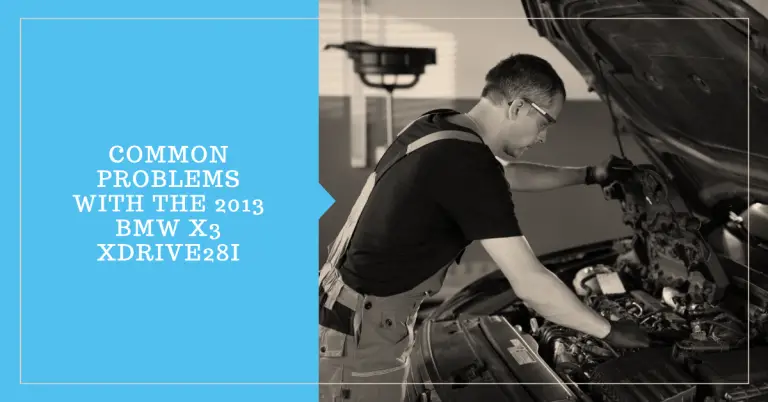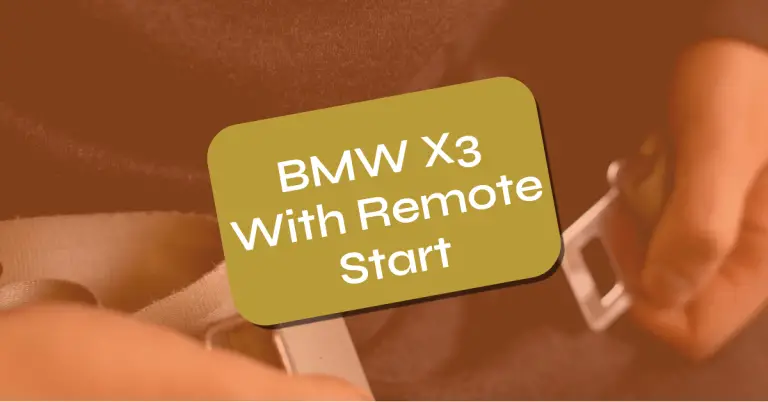How to Check and Maintain Proper Tire Pressure on a BMW X3?
Driving on improperly inflated tires can create a dangerous situation on the road. It leads to uneven tread wear, reduced control, and shorter tire life. So how can BMW X3 owners make sure their tires are inflated to the correct PSI? Checking and maintaining proper tire pressure on an X3 is easy when you have the right tools and knowledge.
This comprehensive guide will cover everything you need to know about proper inflation for your BMW X3 including:
- Finding the recommended tire pressures
- Steps for accurately checking pressure
- When and how often to check
- The benefits of proper inflation
- Risks of underinflation
- Tips for maintaining optimal pressure
What is the Correct Tire Pressure for a BMW X3?
The first step is determining the proper inflation PSI for your specific X3 model and year. BMW recommends different front and rear tire pressures depending on the generation of X3.
2004-2010 BMW X3
For first generation BMW X3 models produced from 2004 to 2010, the automaker calls for:
- 32 PSI in the front tires
- 35 PSI in the rear tires
This slight difference between front and rear pressures helps optimize vehicle dynamics and handling.
2011-2018 BMW X3
Beginning with the second generation X3 from model years 2011-2018, BMW standardized the recommended pressures:
- 35 PSI for both front and rear tires
Equal inflation helps simplify maintenance and produces a balanced ride.
2019+ BMW X3
Current third generation X3s built since 2019 need:
- 36 PSI in all four tires
The higher pressure better suits the new model’s weight, dimensions, and suspension components.
Always defer to the door jamb sticker on your specific X3 for the exact recommended PSI. Manuals can provide helpful guidance, but your vehicle’s label represents the definitive pressures from BMW.
How to Check Tire Pressure on a BMW X3?
Now that you know the target pressures, it’s important to accurately check and monitor your X3’s tire inflation. Here is the proper process:
Use an Accurate Tire Pressure Gauge
The tool you use to measure pressure makes all the difference in getting reliable readings. The optimal gauges for X3 owners are:
- Digital – Easy to use and most precise. Many display PSI on an LCD screen.
- Dial – Also highly accurate if in good calibration. Needs a careful user.
- Stick – Most affordable but can be less reliable. Use as backup gauge.
Avoid free gas station gauges which tend to lose calibration over time. Invest in a quality branded gauge for home.
Check When Tires are Cold
- Only check pressures when tires have sat for 3+ hours and are cold.
- Warm or hot tires from driving will read higher pressures.
- Letting air out of warm tires leads to underinflation when cooled.
Remove Valve Stem Caps
- Twist off the cap covering the valve stem on each wheel.
- Caps keep out debris but must be removed to take a reading.
Place Gauge Straight onto Valve Stem
- Position the gauge directly on the exposed valve stem.
- Press straight on for a tight seal so no air escapes.
- Do not place at an angle or allow leaks.
Take Pressure Reading
- Digital gauges will display PSI on a screen automatically.
- For dial gauges, apply pressure then turn slightly to get needle reading.
- Read stick gauges at highest point of resistance.
Check Reading Against Recommended PSI
- Compare the measured PSI to the target inflation listed on X3’s door jamb sticker.
- Ensure readings are within 1-2 PSI.
Top Off Underinflated Tires
- If any tire is low by 3-4 PSI or more, add air using a compressor.
- Re-check with gauge until reaching the recommended pressure.
Following this best practice procedure ensures your X3’s tires are safely inflated based on BMW engineered specifications.
When to Check BMW X3 Tire Pressure?
Vigilant X3 owners don’t just check pressures when a tire seems low. Monitoring inflation at regular intervals is key to staying on top of proper maintenance.
At least Monthly
- Test pressures on all 4 tires once a month.
- Set a reminder in your calendar or app.
Before Long Trips
- Always measure pressure before a road trip or extended drive.
- Topping off prevents problems miles from home.
After Big Temperature Drops
- Re-check pressures when outdoor temps fall significantly.
- Colder weather causes inflation to drop 1 PSI per 10 degrees.
With Every Oil Change
- Add pressure check to your routine maintenance schedule.
- Most BMWs need oil changes around every 10,000 miles or annually.
After Changing Elevation
- Air expands and contracts when gaining/losing altitude.
- Test inflation after driving in mountains or flying.
By making pressure checks part of your regular X3 maintenance, you’ll stay on top of this critical factor before issues arise.
Maintaining Proper Tire Pressure
Checking pressures routinely is only half the battle. Proper maintenance also means responding promptly if tires are under or overinflated:
Top Off When Low
- Don’t ignore any tires showing 3-4 PSI under recommended.
- Inflate back to correct PSI using a compressor as soon as noticed.
Adjust for Overinflation
- If above recommended PSI, gently release air by pressing valve stem.
- Re-check and remove more air until reaching proper level.
Re-Check After Adjustments
- Always verify final readings after adding or releasing air.
- Confirm tires ended up at the exact right pressure.
Replace Valve Stem Caps
- Reinstall caps on valve stems when finished to keep out moisture and debris.
- Caps are inexpensive to replace if missing or damaged.
Evaluate Wear Patterns
- During tire rotations, mechanics can check for uneven tread wear.
- This may signal prolonged underinflation on a tire.
By responding promptly when pressures are off and making inflation a habit, you can effortlessly keep your X3’s tires in their optimal state.
The Importance of Proper Tire Pressure
Maintaining manufacturer recommended inflation might seem trivial, but there are compelling reasons BMW emphasizes proper PSI:
Enhanced Fuel Economy
- Underinflated tires create more rolling resistance with the road.
- This requires more effort for the engine to propel the vehicle.
- Correct pressures can improve fuel economy by up to 3%.
Improved Braking Distances
- Properly inflated tires allow maximum traction and grip.
- This results in shorter stopping distances which is crucial for safety.
Better Handling and Control
- Low pressures cause tires to flex too much in corners.
- Optimal inflation allows tires to better respond and grip the road.
Reduced Uneven Treadwear
- Underinflation concentrates wear on outer tread edges.
- Maintaining pressures minimizes irregular patterns.
Smoother, Quieter Ride
- The right pressures minimize bounce in the tires over imperfections.
- This creates a more premium driving experience.
For all these reasons, dialing in the recommended PSI results in optimized X3 performance, handling, safety and longevity.
Risks of Underinflated Tires
While 1-2 PSI under won’t cause immediate dangers, sustained underinflation accelerates risks and downsides:
Faster Tread Wear
- Pressures below 30 PSI make the tread scrape and skid.
- Underinflation dramatically shortens useful tire life.
More Prone to Blowouts
- Heat and friction from low pressures degrades the rubber.
- Weak spots can form leading to sudden air loss.
Reduced Traction and Control
- Footprint shrinks with underinflation, creating less grip.
- This impairs braking, accelerating and cornering.
Lower MPG, Higher Costs
- It takes more energy for soft tires to roll down the road.
- Owners spend more on fuel when pressures are low.
Driving for long periods below recommended pressures makes all these issues worse over time. Don’t put it off – inflate for safety and savings.
Tips for Maintaining Proper BMW X3 Tire Pressure
Consistently hitting the right pressures contributes to a smoother, safer, and more efficient X3. Here are some helpful tips:
- Upgrade to digital gauge – More precise than dial/stick models for a moderate cost.
- Check before drive times – Only test cold tires before morning or afternoon commutes.
- Set pressure alerts – Use a smart gauge to receive notifications when low.
- Keep compressor handy – Have one at home and in vehicle to instantly inflate.
- Inspect regularly – Quick visual inspections between full checks.
- Evaluate after impacts – Re-check if a tire hits a pothole or curb hard.
Monitoring pressures takes just minutes but pays dividends for your X3’s performance, handling, tire wear and safety. Dialed-in inflation really maximizes the capabilities BMW engineered into these premium SUVs.
Maintain Optimal Pressure for Your BMW X3
While manufacturers recommend target tire pressures, it ultimately falls on owners to monitor and maintain proper inflation. Paying attention to PSI keeps your tires in an optimal state for safety, handling, longevity and savings at the pump.
Following the steps in this guide makes it easy and efficient to check pressures accurately on your BMW X3. Implementing regular inflation checks and promptly topping off low tires ensures you achieve BMW’s recommended pressures every day you drive. With the right tools and diligence, proper tire pressures become another rewarding part of caring for your Ultimate Driving Machine.







